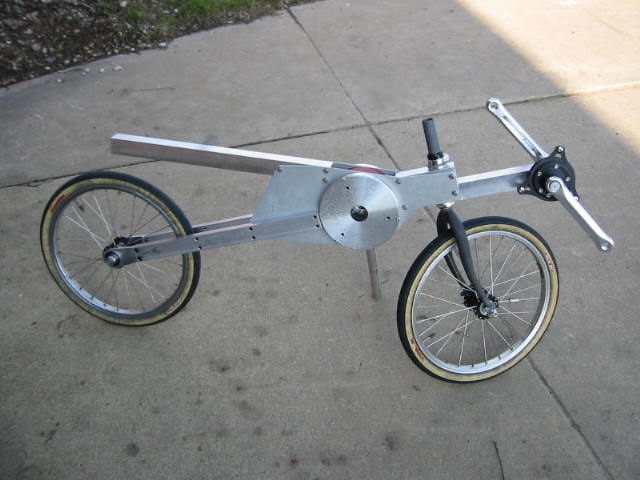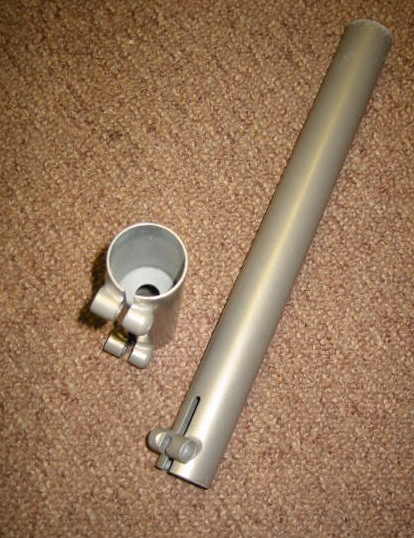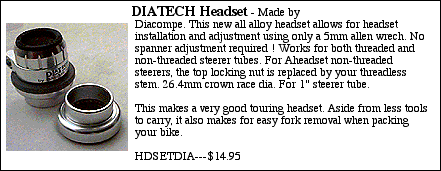
In the class lecture of Jan 28/02 Dr Kremer
gave an overview of the most common design theories and methods,
including Value Engineering and Design for Manufacturability,
Assembly and Simplicity. Since September 2001 I have been designing
an electric bicycle, somewhat in parallel with the Senior Design
sequence, but without some of the restrictions that have been
imposed on the Senior Design project (refer: www.eBiciBikes.com).
In this case study I would like to indicate how we have been using
a combination of these various design methods to develop one small
component of the eBici bike - the clamp that connects the handlebar
stem to the steer tube of the front fork. The bike is being built
in eCycle in PA, and its current hardware configuration is as
shown. Notice the fork steer tube extending above the frame to
which we wish to clamp the handlebar stem.

In 1994 I designed and built the Grasshopper
1 recumbent. Notice the cumbersome method of connecting
the handlebar stem to the fork in the two pictures shown (picture1, picture2).
The fork was manufactured by Vision for their popular line of
recumbents. Subsequently I began working with various components
of the BikeE company,
which currently produces the most popular recumbent design in
the US. Check out the picture of Dr. Bob
proudly sitting on his BikeE, and notice how BikeE connects their
handlebar stem to the fork steer tube in a smooth inline manner
- a significant improvement over the Vision system. Originally
BikeE used the following two tubes - the smaller tube with an
inner washer to connect the "AheadSet" threadless headset,
and the larger tube to connect the handlebar. All the tubes are
connected with binder bolts brazed onto the tube ends.

I very much wanted to use the elegant BikeE system,
but could not resolve the manufacturing difficulty of brazing
the "Aheadset" washer in the center of the small tube.
During 2000 I designed the Grasshopper
5 FWD (front wheel drive) and RWD (rear wheel drive) recumbent
bikes in which I did use a tube system similar to BikeE, however
without the "Aheadset" (refer: picture3).
These bikes use regular threaded steer tubes and headsets, however
inside each steer tube a 6" piece of tubing having the same
diameter as the stem is fixed into place with Loctite adhesive,
with 3" sticking out. The clamping tube then clamps the tubing
on the fork stem as well as the handlebar stem. It was with this
precedent that I came to the design review process in eCycle during
December 2001.
One of the problems of a threaded headset is
the need for two 35 mm spanners for correct adjustment of the
headset bearings. We resolved that by choosing the DiaTech headset
available from Gaerlan, as shown in the following picture taken
from Gaerlan's webpage catalog.

The main feature of this headset (which is relevant to the discussion following) is that the headset bearings are tightened by hand using the threaded locknut, and then clamped into place with a 5mm allen wrench.
When I gave my presentation on the stem clamp design to the design review team at eCycle, then the main response was: "Too complex, not easy to manufacture - we must find a simpler method". It was apparent that the considerations made for a handbuilt prototype are not necessarily suitable for manufacture. In the weeks following we came up with many alternative methods leading to our very elegant final design during January 2002. I do not yet have photographs of the final design so these will be presented in class. If you miss the class and are interested in seeing the final design, please contact me and I will give you copies of the relevant overheads.